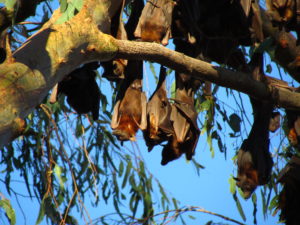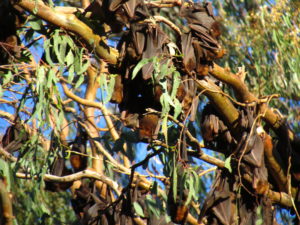
Many people travelling through Roma and Outback Queensland during Spring may notice the presence of fruit bats not present at other times of the year. These are Little Red Flying Foxes (Pteropus scapulatus), and are a bit different from the species of flying foxes on the coast which typically roost in large permanent colonies.
Little Red Flying Foxes are the smallest flying fox species in Australia. They have a reddish-brown body, a grey head and back, and their wings are a transparent brown when flying.
 During the day they can be seen roosting in large camps comprising up to 100,000 individuals or more. But unlike other Australian species, such as the Black Flying Foxes found closer to the coast, Little Red Flying Foxes are a nomadic species. They follow the flowering of trees around Australia, feeding predominantly on nectar and pollen from eucalypt blossoms. They will travel up to 30 kilometres per night to feed, and once the flowering of trees has finished and they have exhausted the food supply, they will move on to another area. Flying-foxes are an important pollinator of many flowering plants.
During the day they can be seen roosting in large camps comprising up to 100,000 individuals or more. But unlike other Australian species, such as the Black Flying Foxes found closer to the coast, Little Red Flying Foxes are a nomadic species. They follow the flowering of trees around Australia, feeding predominantly on nectar and pollen from eucalypt blossoms. They will travel up to 30 kilometres per night to feed, and once the flowering of trees has finished and they have exhausted the food supply, they will move on to another area. Flying-foxes are an important pollinator of many flowering plants.
In Roma and the surrounding region, Little Red Flying Foxes may start turning up around September (depending on flowering and food supplies), with the colony building to a peak in late October, before all of the flying foxes move on in November. If you find yourself camped out under a flying fox colony just remember that it’s illegal ($100,000 fine or 12 months in prison) to disturb, interfere, harm or kill flying foxes. So it’s better to just move your vehicle or camp to another location.
Little Red Flying Fox camps are typically situated in large River Red Gums near permanent water sources. To get a drink of water Little Red Flying Foxes will dip their chest into water as they fly over the surface. Then they’ll lick the water off their chest. Even when flying around, Little Red Flying Foxes will sometimes fly along only a metre off the ground. For this reason many get caught on barbed wire fences.
If you see a flying fox trapped on a fence don’t approach it, as you may stress it out causing it to flap its wings or get even more entangled on the barbed wire. Call RSPCA 1300 ANIMAL or a trained animal rescue person; who will know the best methods to remove the animal from the fence and have the necessary immunisations for working with these animals.

